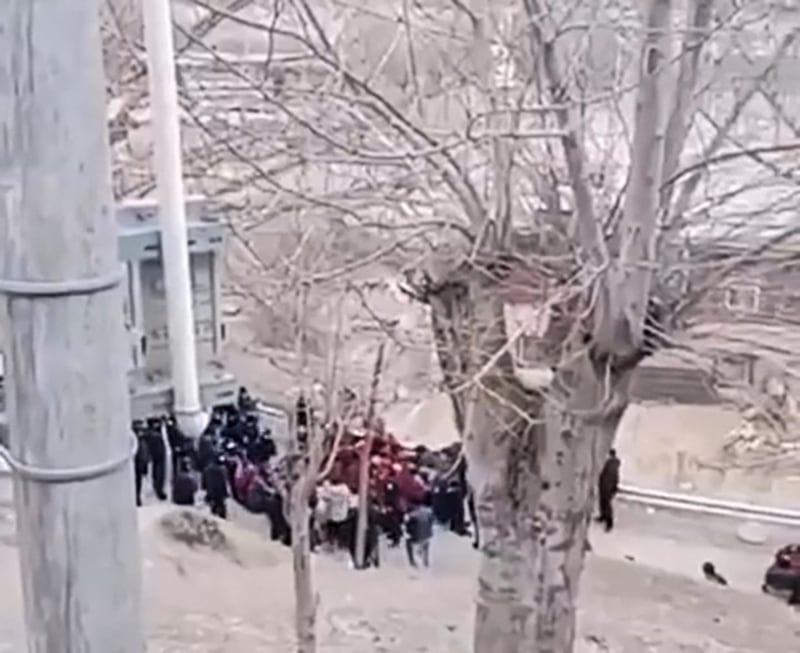UPDATED at 5:40 P.M. ET on 02-26-2024
Chinese officials arrested more than 100 Tibetan monks and other ethnic Tibetans in China’s southwestern Sichuan province on Thursday to quell protests against a massive dam project that would destroy six Buddhist monasteries and force the relocation of two villages, three sources told Radio Free Asia.
In a rare act of defiance, residents have taken to the streets of Wangbuding township in Dege County in Kardze Tibetan Autonomous Prefecture since Feb. 14 to oppose the plan to build the 1,110-megawatt Gangtuo hydropower station on the Drichu River (Jinsha in Chinese), which is located on the upper reaches of the Yangtze, one of China’s most important waterways.
Residents were particularly distraught that construction of the hydroelectric dam would destroy six monasteries, including the Wonto Monastery, which includes ancient murals that date to the 13th century, the sources said.
Citizen videos exclusively shared with RFA show Chinese officials dressed in black forcibly restraining monks, who can be heard crying out against the dam.
Liu Pengyu, a spokesman for the Chinese Embassy in Washington, said he was not aware of the arrests. "China is a country under the rule of law," he said in an emailed statement. "China protects the legitimate rights and interests of Chinese nationals in accordance with the law."
The detentions reportedly occurred in the Kardze Tibetan Autonomous Prefecture in Sichuan, an area with a large population of ethnic Tibetans. Some of the arrested protesters required hospitalization due to rough treatment, sources said.
Local sources who spoke with RFA despite the Chinese government’s effort to restrict communication from the area said police officers used water cannons, pepper spray and tasers to subdue the protesters. The videos shared with RFA do not show those tactics, however.
Rising opposition
The protests started on Feb. 14, when at least 300 Tibetans gathered outside the Dege County Townhall to protest the dam. Such protests are rare in China, particularly among Tibetans, due to strict controls on public gatherings and extensive surveillance by authorities.
The construction of the Gangtuo hydropower dam will force the resettlement of the Upper Wonto and Shipa villages and the Yena, Wonto and Khardho monasteries in Dege county, and the Rabten, Gonsar and Tashi monasteries in Chamdo township, sources told RFA.
The Wonto and Yena monasteries, which are located closest to the site of the planned project, together have about 300 monks and hold significant cultural and religious importance to locals.
The Wonto Monastery was severely damaged during China’s Cultural Revolution. Locals preserved its ancient murals, however, and began rebuilding the monastery in 1983
The number of monks who live and worship at the four other monasteries slated for destruction is not known.
About 2,000 people live in the two villages and would be forced to relocate due to the dam project, sources told RFA.

The Gangtuo dam is part of a plan that China's National Development and Reform Commission announced in 2012 to build a massive 13-tier hydropower complex on the Drichu. It would be located at Wontok (or Gangtuo in Chinese), Dege county, northwest of the Kardze Tibetan Autonomous Prefecture, Sichuan province.
The planned capacity of the 13 hydropower stations is 13,920 megawatts.
Chinese authorities closed all the main roads and imposed strict restrictions, including on digital access, on the villages and monasteries in the Wangbuding township following the Feb. 14 protests.
On Feb 20, as authorities inspected Yena and Wonto monasteries in preparation for their demolition, video footage obtained by RFA showed monks prostrating themselves before the visiting Chinese officials to plead with them to halt the construction of the dam.
The appeals continued today. But by then Chinese officials apparently had had enough, and the arrests began. Officials also reportedly confiscated the mobile phones of protesters. Some locals though avoided arrest and were able to record elements of the crackdown.
Additional reporting by Pelbar and Sonam Lhamo. Edited by Jim Snyder and Malcolm Foster.
Updated to add a comment from the Chinese Embassy and to correct the amount of megawatts of electricity the Gangtuo Dam will produce.
